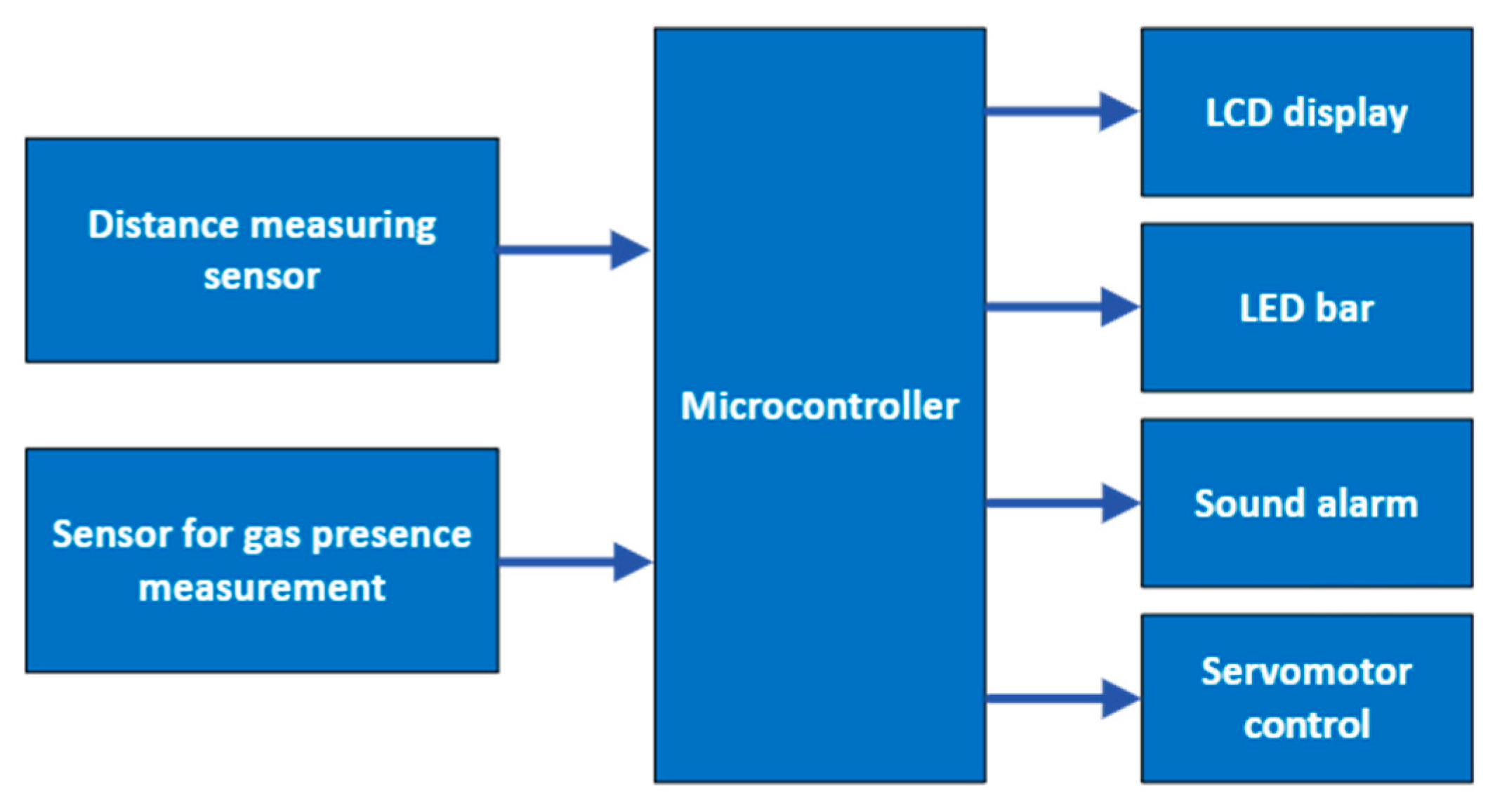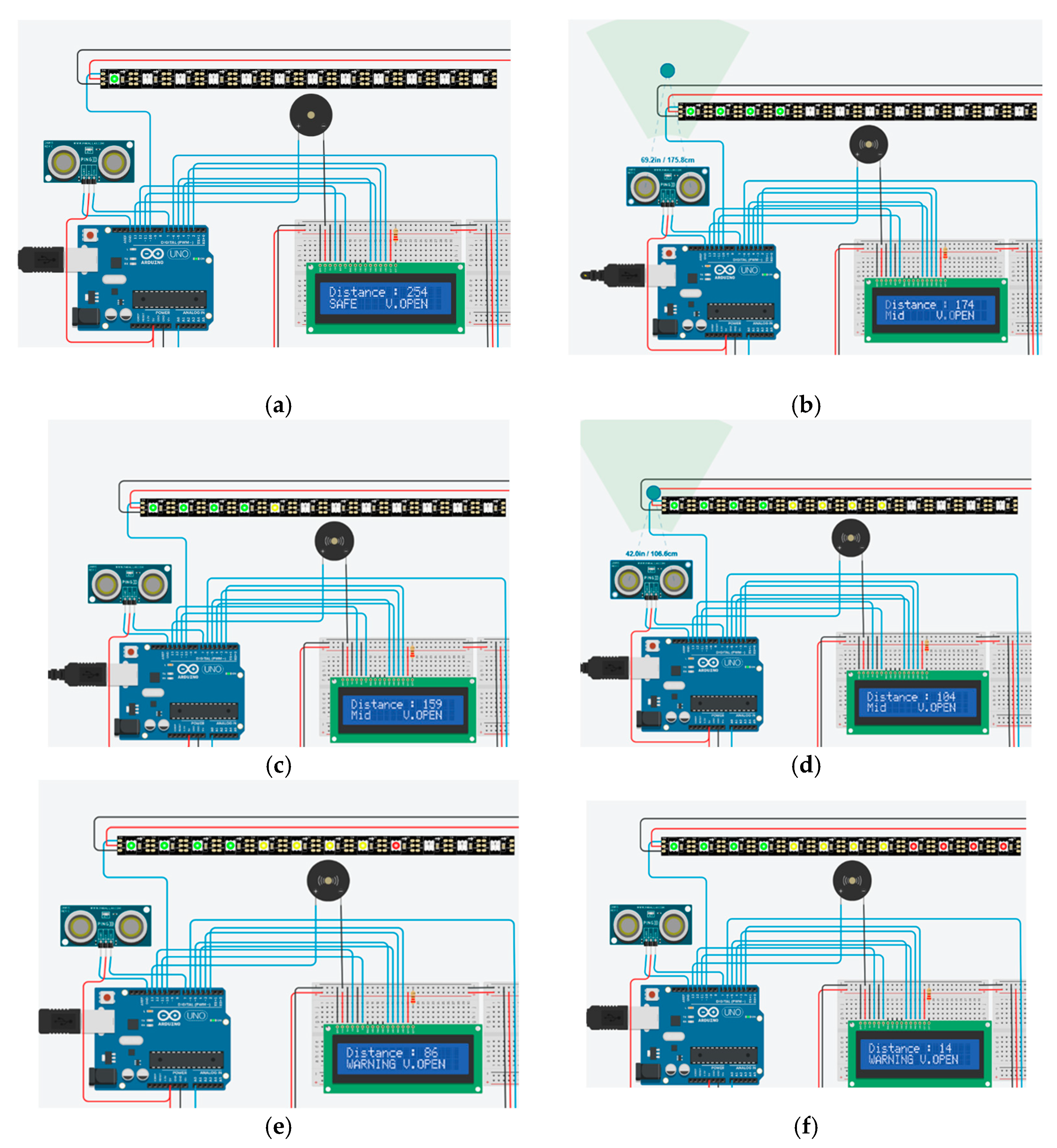Prototype of an Integrated Electronic System for Increased Safety and Comfort in a Car †
Abstract
1. Introduction
2. Methodology for the Development of a Prototype of an Integrated Electronic System for Increased Safety and Comfort in a Car
2.1. Development of a Working Algorithm for the Prototype of the Integrated Electronic Car System
- Step 3: The distance is greater than 250 cm (D > 250 cm), visualization of the distance follows and initialization of the message “Safe” on the LCD display, the beep is turned off—step 4;
- Step 5: Distance is less than 250 cm and greater than 100 cm (250 cm ≥ D > 100 cm), distance visualization and initialization of “Mid” message on LCD follows, audible alarm is triggered—Step 6;
- Step 10: If the presence of gas is greater than 600 ppm (A > 600), the following is the visualization of the measured gas values and the initialization of the message “V_CLOSED” on the LCD display and control of the servomotor in the “CLOSED” position—step 11.
- Step 12: If the presence of gas is less than 600 ppm and greater than 500 ppm (600 ≥ A > 500), the following is the visualization of the measured gas values and the initialization of the “V_CLOSED” message on the LCD display and the servomotor control in the “CLOSED” position—step 13.
- Step 14: If the presence of gas is less than 500 ppm (A < 500), the following is the visualization of the measured gas values and the initialization of the message “V_OPEN” on the LCD display and the control of the servomotor in the “OPEN” position—step 15.
2.2. Development of the Structural Scheme of the Prototype of the Integrated Electronic Car System
- Sensors for distance and gas measurement—to convert the non-electrical quantity into an electrical one;
- Microcontroller—to control the input information from the sensors and output the current results from the same;
- LCD display and LED bar for visualization of measured parameters;
- Audible beeping—for immediate notification to the driver of the vehicle’s dislocation from the nearest object;
- Control—a servomotor is used to control a valve to provide clean air in the cabin of the vehicle.
2.3. Virtual Environment for Simulation and Testing of the Prototype of the Integrated Electronic Car System
3. Results
3.1. Results of a Simulation Study of a Prototype Integrated Electronic Car System
3.2. Practical Implementation of a Prototype of an Integrated Electronic System for Increasing Safety and Comfort in a Car
- Gas sensor—MQ2 sensor is selected, which is a MOS (metal oxide semiconductor) sensor. Metal oxide sensors are also known as hemiresistors because the sensing is based on the change in resistance of the sensing material when exposed to gases [15].
- Ultrasonic Sensor—HC-SR04 ((Elimex Ltd., Ruse, Bulgaria; manufactured in Shenzhen, China))is an affordable and easy-to-use distance measurement sensor that has a range of 2 cm to 400 cm. The sensor is composed of two ultrasonic transducers. One is a transmitter that emits ultrasonic sound pulses and the other is a receiver that listens to the reflected waves. It is essentially a SONAR, which is used in submarines to detect underwater objects [16].
- The UNO board is Arduino’s flagship product. Whether you’re new to the world of electronics, or you’ll be using the UNO R3 as a tool for educational purposes, or for industry-related tasks [17].
- LCD display—liquid crystal display for displaying a series of words or sensor data. A 16 × 2 character LCD display can display 32 ASCII characters in two lines.
- LED bar—WS2812 (Elimex Ltd., Ruse, Bulgaria; manufactured in Shenzhen, China) is selected, which is an intelligent LED light source for control, in which the control circuit and RGB chip are integrated in a package of 5050 components. Internally, it includes an intelligent digital port for data logging and an amplifier to reshape the signal from the drive circuit. It also includes a precision internal oscillator and a programmable constant current 12 V voltage-control part, which effectively guarantees a constant pixel light color height.
- Servo Motor—SG90 (Tower Pro Pte Ltd., Shenzhen, China; supplied by Elimex Ltd., Ruse, Bulgaria) was selected which is a hobby type servo position control motor and has the ability to control its position approximately 180 degrees. This is a standalone package including motor, feedback sensor and driver, and only 3 wires are required to control the position [18].
- As in any electronic equipment, we have a power supply module providing the necessary voltages and currents for the normal operation of the integrated electronic system. In the car, the constant voltage is 12 V, and to power the electronic system the voltage needs to be reduced to 5 V.
4. Discussion
5. Conclusions
Author Contributions
Funding
Institutional Review Board Statement
Informed Consent Statement
Data Availability Statement
Conflicts of Interest
References
- Kompass, K.; Huber, W.; Helmer, T. Safety and Comfort Systems: Introduction and Overview. In Handbook of Intelligent; Eskandarian, A., Ed.; Vehicles Springer: London, UK, 2012. [Google Scholar] [CrossRef]
- Ramya, V.; Palaniappan, B.; Karthick, K.; Prasad, S. Embedded System for Vehicle Cabin Toxic Gas Detection and Alerting. Procedia Eng. 2012, 30, 869–873. [Google Scholar] [CrossRef]
- Goh, C.C.; Kamarudin, L.M.; Zakaria, A.; Nishizaki, H.; Ramli, N.; Mao, X.; Syed Zakaria, S.M.M.; Kanagaraj, E.; Abdull Sukor, A.S.; Elham, M.F. Real-Time In-Vehicle Air Quality Monitoring System Using Machine Learning Prediction Algorithm. Sensors 2021, 21, 4956. [Google Scholar] [CrossRef] [PubMed]
- Shehab, J. The Smart Parking System Using Ultrasonic Control Sensors. IOP Conf. Ser. Mater. Sci. Eng. 2021, 1076, 012064. [Google Scholar] [CrossRef]
- Xu, S.; Ni, Y. Design of ultrasonic parking system based on lab VIEW. J. Softw. Eng. Simul. 2023, 9, 1–14. [Google Scholar]
- Kumar, B.; Prakash, G.; Logapriya, P.; Sowmiya, A. Smart Parking System Using Arduino and Sensors. Nat. Camp. 2024, 28, 2903–2911. [Google Scholar]
- Panahi, U.; Bayilmis, C. Car indoor gas detection system. In Proceedings of the International Conference on Computer Science and Engineering (UBMK), Antalya, Turkey, 5–8 October 2017. [Google Scholar] [CrossRef]
- Pekhale, S.; Shirsat, P.; Jadhav, P.; Shedge, K.; Jachak, S. IoT based intelligent car system for preventing suffocation in closed car cabin using sensors. Int. J. Adv. Sci. Res. Eng. Trends 2020, 5, 18–26. [Google Scholar]
- Jung, H.S.; Grady, M.L.; Victoroff, T.; Miller, A.L. Simultaneously reducing CO2 and particulate exposures via fractional recirculation of vehicle cabin air. Atmos. Environ. 2017, 160, 77–88. [Google Scholar] [CrossRef] [PubMed]
- Jeon, S.; Seo, D. Smart Parking System Based on an Ultrasonic Sensor and Bluetooth Low Energy in the Internet of Things. J. Syst. Manag. Sci. 2019, 9, 91–110. [Google Scholar] [CrossRef]
- ISO 20900:2023; Intelligent Transport Systems—Partially-Automated Parking Systems (PAPS)—Performance Requirements and Test Procedures. International Organization for Standardization: Cham, Switzerland, 2023.
- ISO 12219-1:2021; Interior Air of Road Vehicles—Part 1: Whole Vehicle Test Chamber—Specification and Method for the Determination of Volatile Organic Compounds in Cabin Interiors. International Organization for Standardization: Cham, Switzerland, 2021.
- Abburi, R.; Praveena, M.; Ramagiri, P. TinkerCad—A Web Based Application for Virtual Labs to help Learners Think, Create and Make. J. Eng. Educ. Transform. 2021, 34, 535. [Google Scholar] [CrossRef]
- Jacob, F.; Alberto, A.; Guimarães, P. Use of Tinkercad platform for Teaching Electronics Subject in Post-Secondary Technical Courses. In Proceedings of the Ninth International Conference on Technological Ecosystems for Enhancing Multiculturality (TEEM’21), Barcelona, Spain, 26–29 October 2021; ACM: New York, NY, USA, 2021. [Google Scholar] [CrossRef]
- Trisnawan, K.; Jati, A.; Wasisto, N. Detection of Gas Leaks Using The MQ-2 Gas Sensor on the Autonomous Mobile Sensor. In Proceedings of the International Conference on Computer, Control, Informatics and Its Applications (IC3INA), Tangerang, Indonesia, 23–24 October 2019. [Google Scholar]
- Abdulkhaleq, N.; Hasan, I.; Salih, N. Investigating the resolution ability of the HC-SRO4 ultrasonic sensor Investigating the resolution ability of the HC-SRO4 ultrasonic sensor. IOP Conf. Ser. Mater. Sci. Eng. 2020, 745, 012043. [Google Scholar] [CrossRef]
- Available online: https://docs.arduino.cc/resources/pinouts/A000066-full-pinout.pdf (accessed on 23 April 2025).
- Available online: http://www.ee.ic.ac.uk/pcheung/teaching/DE1_EE/stores/sg90_datasheet.pdf (accessed on 23 April 2025).





Disclaimer/Publisher’s Note: The statements, opinions and data contained in all publications are solely those of the individual author(s) and contributor(s) and not of MDPI and/or the editor(s). MDPI and/or the editor(s) disclaim responsibility for any injury to people or property resulting from any ideas, methods, instructions or products referred to in the content. |
© 2025 by the authors. Licensee MDPI, Basel, Switzerland. This article is an open access article distributed under the terms and conditions of the Creative Commons Attribution (CC BY) license (https://creativecommons.org/licenses/by/4.0/).
Share and Cite
Zaharieva, S.; Stoev, I.; Chobanov, V.; Enev, P.; Borodzhieva, A.; Neikov, Y. Prototype of an Integrated Electronic System for Increased Safety and Comfort in a Car. Eng. Proc. 2025, 104, 61. https://doi.org/10.3390/engproc2025104061
Zaharieva S, Stoev I, Chobanov V, Enev P, Borodzhieva A, Neikov Y. Prototype of an Integrated Electronic System for Increased Safety and Comfort in a Car. Engineering Proceedings. 2025; 104(1):61. https://doi.org/10.3390/engproc2025104061
Chicago/Turabian StyleZaharieva, Snezhinka, Iordan Stoev, Veselin Chobanov, Presian Enev, Adriana Borodzhieva, and Yavor Neikov. 2025. "Prototype of an Integrated Electronic System for Increased Safety and Comfort in a Car" Engineering Proceedings 104, no. 1: 61. https://doi.org/10.3390/engproc2025104061
APA StyleZaharieva, S., Stoev, I., Chobanov, V., Enev, P., Borodzhieva, A., & Neikov, Y. (2025). Prototype of an Integrated Electronic System for Increased Safety and Comfort in a Car. Engineering Proceedings, 104(1), 61. https://doi.org/10.3390/engproc2025104061






